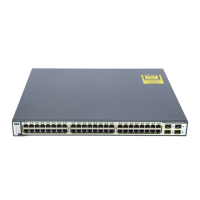31-30
Catalyst 3750 Switch Software Configuration Guide
78-16180-02
Chapter 31 Configuring Network Security with ACLs
Configuring VLAN Maps
Configuring VLAN Maps
This section describes how to configure VLAN maps, which is the only way to control filtering within
a VLAN. VLAN maps have no direction. To filter traffic in a specific direction by using a VLAN map,
you need to include an ACL with specific source or destination addresses. If there is a match clause for
that type of packet (IP or MAC) in the VLAN map, the default action is to drop the packet if the packet
does not match any of the entries within the map. If there is no match clause for that type of packet, the
default is to forward the packet.
Note For complete syntax and usage information for the commands used in this section, refer to the command
reference for this release.
To create a VLAN map and apply it to one or more VLANs, perform these steps:
Step 1 Create the standard or extended IP ACLs or named MAC extended ACLs that you want to apply to the
VLAN. See the “Creating Standard and Extended IP ACLs” section on page 31-7 and the “Creating a
VLAN Map” section on page 31-31.
Step 2 Enter the vlan access-map global configuration command to create a VLAN ACL map entry.
Step 3 In access map configuration mode, optionally enter an action—forward (the default) or drop—and
enter the match command to specify an IP packet or a non-IP packet (with only a known MAC address)
and to match the packet against one or more ACLs (standard or extended).
Note If the VLAN map has a match clause for the type of packet (IP or MAC) and the packet does not
match the type, the default is to drop the packet. If there is no match clause in the VLAN map
for that type of packet, and no action specified, the packet is forwarded.
Step 4 Use the vlan filter global configuration command to apply a VLAN map to one or more VLANs.
This section contains these topics:
• VLAN Map Configuration Guidelines, page 31-30
• Creating a VLAN Map, page 31-31
• Applying a VLAN Map to a VLAN, page 31-34
• Using VLAN Maps in Your Network, page 31-34
VLAN Map Configuration Guidelines
Follow these guidelines when configuring VLAN maps:
• If there is no ACL configured to deny traffic on an interface and no VLAN map is configured, all
traffic is permitted.
• Each VLAN map consists of a series of entries. The order of entries in an VLAN map is important.
A packet that comes into the switch is tested against the first entry in the VLAN map. If it matches,
the action specified for that part of the VLAN map is taken. If there is no match, the packet is tested
against the next entry in the map.

